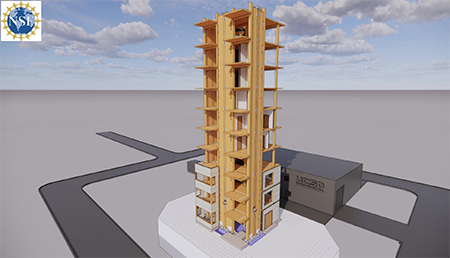Historic Shake Planned for NHERI Tallwood at UC San Diego
Published on October 28, 2021

Scale drawing of NHERI Tallwood building. (Source: Shiling Pei)
View an animated preview of the NHERI Tallwood specimen under construction.
The goal of the NHERI Tallwood project, a long-term, multi-disciplinary research effort, is to show that tall buildings constructed of wood can be designed to achieve resilient goals in the face of earthquakes. In the summer of 2022, the Tallwood team will demonstrate and validate their design methodology using a full-scale, 10-story mass-timber building on the newly upgraded LHPOST6 shake table at NHERI at UC San Diego.
The Tallwood specimen will be the worlds tallest full-scale building ever tested. Tallwood also will be the first major test on the NHERI at UC San Diego shake table, now capable of 6DOF ground motions.
After being subjected to multiple design-level earthquakes, the structural system of the tall wood building is expected to be damage free. The structure, constructed with a mass-timber gravity frame and rocking walls, will also incorporate non-structural elements and contents that are designed to minimize earthquake damage. The test building represents a marketable wood-building archetype.
The PIs involved in the experiment are Shiling Pei from Colorado School of Mines, John van de Lindt from Colorado State University, Jeffrey Berman from University of Washington, Keri Ryan from University of Nevada Reno, and James Dolan from Washington State University.
Procurement and production on the specimen are underway. Stay tuned for updates on construction and instrumentation. For the more details on this historic, multifaceted project, visit the Tallwood webpage.
There is still time for researchers or engineers to provide payload testing ideas on non-structural elements and contents. Contact project PI, Shiling Pei.
This research project is supported by the National Science Foundation through a number of collaborative awards including: CMMI 1636164, CMMI 1634204, CMMI 1635363, CMMI 1635227, CMMI 1635156, CMMI 1634628. The use of the NHERI experimental facility is supported by the National Science Foundations Natural Hazards Engineering Research Infrastructure (NHERI) program.





